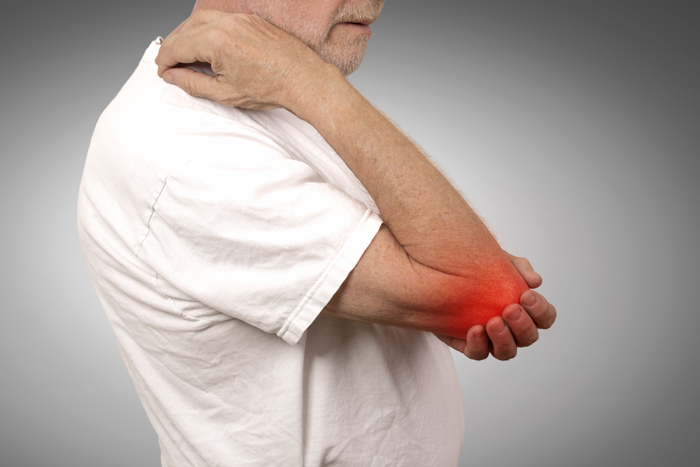Total Elbow Replacement Surgery in Karol Bagh, Delhi
Total elbow replacement surgery is a fairly complicated procedure. Part of the reason is that your elbow has quite a few moving parts that are responsible for precisely balancing each other to control your forearm’s movements. There are many problems that may cause damage to your elbow including rheumatoid arthritis and traumatic fractures. Surgery can repair the damage sometimes, but in cases of extensive damage, an orthopedic surgeon near you might suggest a total elbow replacement surgery.
What is total elbow replacement?
If you are suffering from severe arthritis or your elbow joint has multiple fractures, you might be in need of a total elbow replacement. In this surgery, the surgeon replaces the elbow joint with an artificial joint.
The artificial joint comprises two metal stems and a hinge that is composed of metal or plastic. Your surgeon will insert the stems inside the canal (hollow part of the bone) during the surgery. The most common reason for getting a total elbow replacement in New Delhi is pain.

What are the causes/indications for total elbow replacement?
There are many conditions that may cause elbow pain that ultimately leads to getting a total elbow replacement in New Delhi:
Osteoarthritis: The most common form of arthritis, this is an age-related condition. The cartilage cushioning the elbow’s bones wears away resulting in stiff and painful elbow joints.
Rheumatoid Arthritis: This autoimmune disease causes the inflammation of the synovial membrane surrounding the joint. It can damage the cartilage and ultimately lead to cartilage loss, pain as well as stiffness.
Post-traumatic Arthritis: It is a rare disorder that can seriously injure your elbow. It can cause severe pain to your elbow and limit its function drastically.
Severe Fractures: If one or more bones get severely fractured, you may need an elbow replacement. This replacement surgery is better for a shattered elbow than putting the pieces of a bone back in its place.
Instability: This happens when the ligaments holding the elbow joint together get damaged and stop working efficiently. It occurs most often due to an injury.
What are the types of elbow replacement?
In some cases, a surgeon will replace only one portion of the joint. For instance, if there is damage in just the head of one of the forearm bones (radius), the doctor can replace it with an artificial head.
On the other hand, if there is a case that requires the replacement of the entire joint, your surgeon will remove the ends of the bones coming together in your elbow.
The two major kinds of prosthetic devices available are:
Linked: This type of implant offers your joint good stability. However, the stress arising from the movement may lead to the implant getting loose from the place where your surgeon inserted it into your arm bones. These implants serve as a loose hinge since all the parts of the replacement joint are linked.
Unlinked: These implants are available in two separate pieces that do not connect to each other. It depends on the ligaments that surround it so as to hold the joint together. Thus, they reproduce the natural anatomy of the joint to the fullest.
When do you need to see a doctor?
If you experience pain in your joints followed by some relief or if your elbow aches after extensive use, please contact an orthopedic surgeon near you. If your elbow’s motion reduces substantially and your joints feel stiff after being inactive, your doctor may recommend a total elbow replacement surgery to relieve your pain.
Request an appointment at Apollo Spectra Hospitals, Karol Bagh, New Delhi.
Call 1860 500 2244 to book an appointment.
Conclusion
After a total elbow replacement in New Delhi, your doctor will recommend simple exercises and physical therapy so that your arms become stronger and better. While elbow replacement will reduce the pain and allow your elbow to work better, don’t expect the joint to be as good as before. Avoid activities that may cause injury to your new elbow.
During the first 3 weeks after surgery, you will have to keep it on most of the time. It helps protect the elbow replacement. Gradually, after 3 weeks, you won’t have to wear it that much. But, it may take up to 6 weeks or more to go without it at all times.
You will require rest for around 6 to 8 weeks. If your job requires you to do overhead activities, you will be advised to not indulge in them for 3 to 6 months. Please discuss in detail with an orthopedic surgeon near you, especially if your job involves lifting and heavy manual work.
Before going in for the surgery, share your medical history with your doctor accurately. It is important to make them aware of any conditions or allergies you have. Similarly, tell them about your medicines, supplements, vitamins and alcohol intake. Stop smoking before surgery.
Symptoms
Our Top Specialities
NOTICE BOARD
CONTACT US
CONTACT US
 Book Appointment
Book Appointment


.svg)
.svg)
.svg)
.svg)








